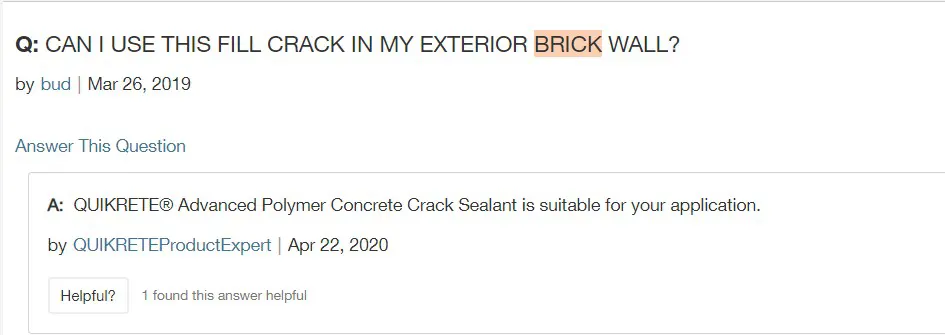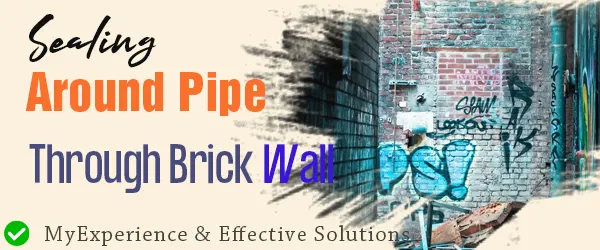Recently I have shifted from a rented apartment to a new home with my family. This is a beautiful home, its brick walls seem very classy from the outside.
I have noticed a pretty sizable gap around the drain pipe through a brick wall. I was not pretty sure whether filling this gap would be right or not. After some research, I found that any kind of gap in the wall creates a big problem in the future, and fixing them at the right time would be beneficial.
I’ve applied some working and effective ways to seal the gap around the pipe through a brick wall, which I’m going to share in this article.
Before we jump to direct solutions, let’s understand some very important things about the cause of the gaps, what problems you have to face if you ignore them and what are some golden solutions to seal those gaps.
Table of Contents
What Is The Reason Behind Gap Around Pipe Through Brick Wall?
One main cause of this problem is drilling. There are many occasions when we have to drill through brick walls:
- Installing sump pumps.
- Feeding waste pipe outside of your garage, bathroom, or kitchen.
- Installing a condensate pipe outside from a boiler.
Why Filling Gap Around Pipe Through Your Home Brick Wall Is Important?
Gaps and cracks around pipes in your home can create so many problems. Many homeowners often ignore those small gaps and crack around the drainage pipe, later on, they have to face some major problems due to this mistake.
What Problems You Could Face If You Don’t Seal Gap Around A Pipe Through Brick Wall?
Usually, when you drill the brick wall or masonry wall for drainage pipe, or for other pipes installation, it creates gaps around the pipe that enter or exit your home.
It would be better to see those problematic gaps as soon as possible to avoid these problems in your home:
1. Water Ingress Problem:
Water Ingress is something when the water penetrates its way through gaps inside your home. It causes some big problems in your home such as the plaster of walls pealing out, mold, rod, etc.
2. Draft Problem:
A gap around the pipe creates a draft problem. A draft creates so many problems such as cold air going outside during summer, and cold air coming inside your home during winter. This is what is totally opposite to what you want and requires an immediate fix.
3. Easy Invitation To Insects And Pest
Gaps and cracks between the pipe and brick wall are easy invitations to those guests, you don’t want to meet such as mice, cockroaches, moths, etc.
4. Increase Your Electricity Bill
Brick wall gaps allow cold air to enter your home, and allow warm air in your room to pass through the wall and that causes your electric bill to skyrocket.
5. Gaps Mitigate The Look Of Your Home
Pipes through the brick wall appear from the outside and if there is a gap between the pipes and the wall it looks very odd and makes the overall look of your home outdated.
My Personal Experience To Fix The Gap Around A Pipe Through Brick Wall [Step-By-Step Guide]
You have to seal the gap between the pipe and brick wall inside and outside of your home. In each case, you need to use different materials for effective sealing.

Equipment Required For This Process
- Safety gloves
- Safety eye google
- Hammer
- Caulk gun
- Loctite Tile Foam
- Quickrete Advanced Polymer Concrete Crack Sealant
- Cement
- Utility Knife
- Chisel
- Bucket
- Sponge
1. Seal The Gap Between The Pipe And Brick Wall Inside Your Home
These simple steps will help you to get rid of those nasty gaps between the pipe and brick wall of your home:
Step 1: Clean The Surface Properly
if you want perfect sealing around the gap, You need to remove any dirt or debris from the surface by using a dry cloth, a small brush, etc.
You can also use a vacuum cleaner to ensure optimum cleaning. You can apply a trick to clean some hard-to-reach areas. Use a small tube and attach it to the hose of the vacuum cleaner using a tap. This way you are able to clean the whole surface effectively.
Step 2: Use Some Good Quality Sealant Materials
Using the right sealant material is the backbone of the whole repair process. You should aware of what material performs best with which surface.
1. Use Expansion Foam
After cleaning the surface thoroughly, this is the time to use a good quality expansion foam around the pipe.
If the size of the gap is 1 inch then I would recommend using Loctite Tite Foam, this is a kind of expansion foam, which has the capability to expand three times its actual shape post-application.
The Loctite Tile Foam is compatible with most surfaces such as Wood, Brick, Concrete, Metal, and Stone.
2. Use Cement
Cement is a strong, durable, and long-lasting material that can be used to fill gaps and cracks in brick walls.
- The first step is to make a square hole around the gap if the gap is narrow, it helps to apply the cement very well. You can use a hammer and chisel for this.
- The second step is to prepare the mixing area. Find an area that’s free from dirt, debris, and other materials that could get in the way. Make sure there’s enough room for you to stand comfortably.
- The third step is to mix up a batch of cement. Pour some water into the mixing container. Make sure don’t apply too much water otherwise it won’t work. Read the instruction on the cement packaging.
- At last, apply the cement around the gap using your hand. Make sure you wear safety gloves first. You can also use some tools like a margin trowel for this. Apply the cement into the gap to fill all the small-large voids.
- Now it’s time to smoothen the surface, you can use a damp sponge for this.
Step 3: Leave The Surface To Cure Properly
Whatever method you use to seal the gap between the pipe and brick wall, when you have done with the sealing process, leave the surface for a few days to cure it properly.
2. Seal The Gap Between The Pipe And Brick Wall Outside Your Home
After sealing the gaps inside your house, it is time to seal them from the outside. The outdoor atmosphere is totally different from the inside, and you have to use a different sealant to fix the gap between the pipe and the brick wall.
I’ve discussed a step-by-step guide for sealing such types of gaps:
Clean The Outside Surface
You have to clean the outside surface around the pipe and brick wall by using a brush, rags, and some water.
Apply Caulking
Caulking is the most effective and easy method to fill any kind of gap. Make you use the right sealant for caulking to ensure you don’t face any problems of leakage in the future.
I would strongly recommend using Quikrete Advanced Polymer Concrete Crack Sealant. Most sealants do not work effectively with plastic but Quickrete Advance works. Don’t be confused with the word concrete here, this material is also effective with brick walls. See the screenshot in which a Quickrete Product Expert replied to a customer query regarding this.

The sealant from Quickrete is more effective than the Polyurethane and silicon-based sealant.
It performs well with most plastic pipes. This is a perfect sealant for outdoor which prevents water and ice damage.
Leave It For A Few Days For Cure
After applying the caulk, you have to wait for a couple of days so that it can cure perfectly and become hard and make a leakage-proof cover around the gap.
Now you are all done and have successfully applied the sealant both inside and outside.
Also Read: How To Seal The Gap Between The PVC Pipe And Concrete
Conclusion
Any kind of gaps and cracks need attention and you have to immediately fix them for any future discomfort. Gaps around a pipe through a brick wall are not a big deal to seal, the main thing is you have proper knowledge about the material and some techniques to fix them.
There is no single best way to seal a gap this is why I’ve mentioned different ways to seal the gap properly. I hope this article has covered all of the best possible methods to seal the gap between pipe and brick walls.
Safety Tips & Precautions
Always wear safety gear before fixing anything at your home. This is especially mandatory when you have to deal with some harmful materials such as Foam sealant, cement, etc.
These types of materials become hand when cure and it becomes really a tough job to remove them from your clothes and hands.
Foam sealants are flammable also and avoid using them near the source of the fire.
FAQ
Q.1 What Is The Best Way To Seal The Gap Around The Pipe Through The Brick Wall?
Ans: The best way to seal such type of gap is using expanding foam, if you do this inside of your home, or outside you can use Quickrete Advance Sealant.
Q.2 What Are Some Other Ways To Seal Around A Pipe Through A Brick Wall?
Ans: Using Loctite like expanding foam and Quickrete advance sealant you can easily fix the gap issue between the pipe and brick wall but there are also other working methods to do so such as cementing, caulking, etc.
Q.3 How Long Will It Take To Seal Around A Pipe Through A Brick Wall?
Ans: It will take a few days to cure perfectly.
Q.4 What Will Happen If The Seal Isn’t Tight Enough?
Ans: If the seal isn’t tight enough, the water will leak, and mice and insects enter the home through the gap.
